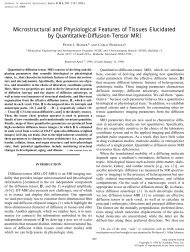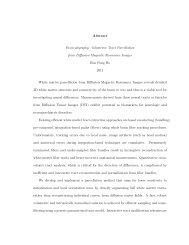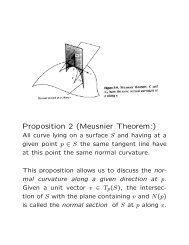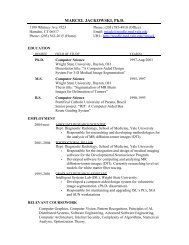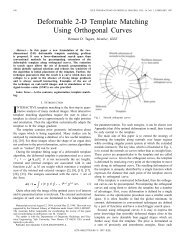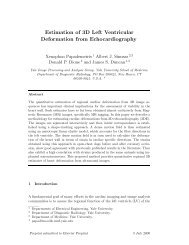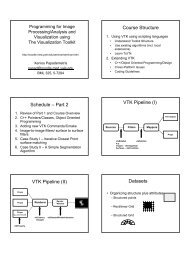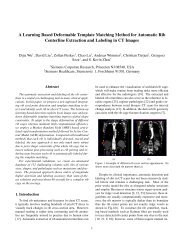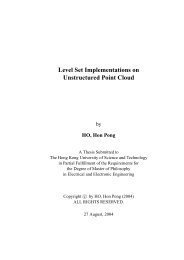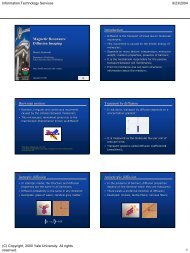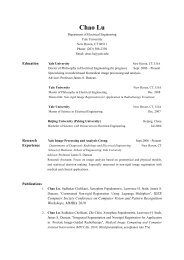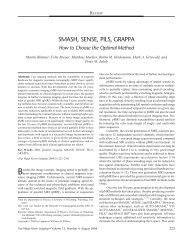Pulsed-field gradient nuclear magnetic resonance as a tool for ...
Pulsed-field gradient nuclear magnetic resonance as a tool for ...
Pulsed-field gradient nuclear magnetic resonance as a tool for ...
You also want an ePaper? Increase the reach of your titles
YUMPU automatically turns print PDFs into web optimized ePapers that Google loves.
310<br />
PRICE<br />
tion is sufficiently long so that we still get a<br />
me<strong>as</strong>urable signal and that the me<strong>as</strong>urement is<br />
unaffected by eddy currents or other experimental<br />
complications see, <strong>for</strong> example, ref. Ž 19 ..<br />
However, in the c<strong>as</strong>e of a species diffusing within<br />
a confined space we must be careful to properly<br />
account <strong>for</strong> the effects of the restricting geometry<br />
on the motion of the species. If a particle is<br />
diffusing within a restricted geometry Žsometimes<br />
referred to <strong>as</strong> a ‘‘pore’’ . , the displacement along<br />
the z-axis will be a function of , the diffusion<br />
coefficient, and the size and shape of the restricting<br />
geometry. Consequently, if the boundary effects<br />
are not properly accounted <strong>for</strong> and we analyze<br />
the data using the model <strong>for</strong> free diffusion<br />
Ž see the next section . , we will me<strong>as</strong>ure an apparent<br />
diffusion coefficient Ž D . app and not the true<br />
diffusion coefficient. We illustrate this effect later<br />
in this section.<br />
Be<strong>for</strong>e further considering the problem of restricted<br />
diffusion, it is appropriate to briefly consider<br />
what constitutes the true diffusion coefficient.<br />
In a pure liquid Ž e.g., water. the true diffusion<br />
coefficient corresponds to the bulk diffusion<br />
coefficient. However, the situation is rather more<br />
complex in a macromolecular solution Že.g.,<br />
cell<br />
cytopl<strong>as</strong>m, polymer solutions, protein solutions,<br />
etc. . where the probe molecule Ž e.g., water. h<strong>as</strong> to<br />
skirt around the larger ‘‘obstructing’’ molecules<br />
Ž e.g., proteins, organelles. <strong>as</strong> well <strong>as</strong> perhaps interacting<br />
with protein hydration shells e.g.,<br />
Ref.<br />
Ž 67 ..<br />
These effects operate on a time scale much<br />
smaller than the smallest experimentally available<br />
and consequently are well averaged on the time<br />
scale of . For example, if we consider a re<strong>as</strong>onably<br />
small value of of 5 ms and that at 298 K<br />
water h<strong>as</strong> a diffusion coefficient of about 2.3 <br />
9 2 1 Ž . <br />
10 m s 68, 69 , then from Eq. 30 the mean<br />
displacement of a water molecule during is<br />
about 5 m. The true diffusion coefficient will be<br />
an average bulk diffusion coefficient consisting of<br />
all of the interactions that affect the probe<br />
molecule diffusion. The situation can be further<br />
complicated by the effects of exchange through<br />
cell membranes Ž 70 . . The different time scales of<br />
the averaging processes is one of the major re<strong>as</strong>ons<br />
that diffusion probed by using relaxation<br />
studies and diffusion me<strong>as</strong>ured using PFG NMR<br />
are essentially different things with the relaxation<br />
b<strong>as</strong>ed me<strong>as</strong>urements probing motion on the time<br />
scale of the correlation time of the probe molecule<br />
and not on the Ž much longer. time scale of <br />
Ž 21, 71 . . We mention in p<strong>as</strong>sing that in a polymer<br />
solution if the diffusion of the polymer itself is<br />
studied there can be additional complications owing<br />
to the entanglement of the polymer molecules<br />
e.g., Ref Ž 19. and references therein .<br />
We now explain the concept of restricted diffusion<br />
and how it relates to PFG NMR diffusion<br />
me<strong>as</strong>urements. Consider two c<strong>as</strong>es where we have<br />
a particle with the same diffusion coefficient; in<br />
one c<strong>as</strong>e the particle is freely diffusing Ži.e.,<br />
an<br />
isotropic homogeneous system . , while in the other<br />
c<strong>as</strong>e it is confined to a reflecting sphere of radius<br />
R Ž Fig. 4 . . By ‘‘reflecting’’ we mean that the spin<br />
is neither transported through the boundary nor<br />
relaxed by the contact with the boundary. From<br />
Eq. 30 ,<br />
we can define the dimensionless variable<br />
Ž i.e., n 1, t . ,<br />
2 <br />
DR , 34<br />
which is useful in characterizing restricted diffusion<br />
<strong>as</strong> will be seen below. In the c<strong>as</strong>e of freely<br />
diffusing particles, the diffusion coefficient determined<br />
will be independent of and the displacement<br />
me<strong>as</strong>ured in the z-direction will reflect the<br />
true diffusion coefficient, since the mean-squared<br />
displacement scales linearly with time Žsee<br />
Eq.<br />
33 . . However, <strong>for</strong> the particle confined to the<br />
sphere, the situation is entirely different. For<br />
short values of such that the diffusing particle<br />
h<strong>as</strong> not diffused far enough to feel the effect of<br />
the boundary Ž i.e., 1 . , the me<strong>as</strong>ured diffusion<br />
coefficient will be the same <strong>as</strong> that observed<br />
<strong>for</strong> the freely diffusing species. As becomes<br />
finite Ž i.e., 1 . , a certain fraction of the particles<br />
Ži.e.,<br />
in a real NMR experiment there is an<br />
ensemble of diffusing species. will feel the effects<br />
of the boundary and the mean squared displacement<br />
along the z-axis will not scale linearly with<br />
; thus, the me<strong>as</strong>ured diffusion coefficient Ži.e.,<br />
D . will appear to be Ž observation. app<br />
time depen-<br />
dent. At very long , the maximum distance that<br />
the confined particle can travel is limited by the<br />
boundaries, and thus the me<strong>as</strong>ured mean-squared<br />
displacement and diffusion coefficient becomes<br />
independent of . Thus, <strong>for</strong> short values of the<br />
me<strong>as</strong>ured displacement of a particle in a restricting<br />
geometry observed via the signal attenuation<br />
in the PFG experiment is sensitive to the diffusion<br />
of the particle. At long the signal attenuation<br />
becomes sensitive to the shape and dimensions<br />
of the restricting geometry. The relationships<br />
between the experimental parameters are<br />
further examined in the next section. If the restricting<br />
geometry is spherically symmetric, then<br />
there will be no-orientational dependence with



